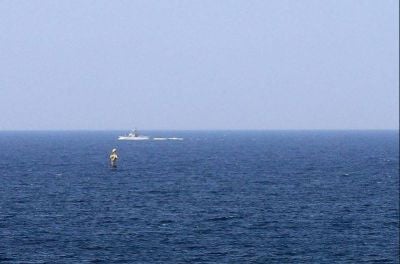
The Lebanese flag flies in the locality of Naqoura, on the border with Israel. (Credit: Aziz Taher/Reuters)
The maritime demarcation agreement between Israel and Lebanon seems to have been reached. Israeli Prime Minister Yair Lapid announced Tuesday in a statement that a “historic” deal on this issue had been agreed.
On the Lebanese side, President Michel Aoun said Tuesday morning that he hoped the agreement would be “announced as soon as possible.” The presidential camp clearly wants to finalize the agreement before the end of Aoun’s term on Oct. 31.
Lapid, for his part, wants the agreement to be ratified before the parliamentary elections in Israel, scheduled for Nov. 1. However, its final conclusion still depends on political and legal factors on both sides of the border. L’Orient-Le Jour reports on what's next for both sides.
For Lebanon
Lebanon must first officially approve the latest proposal by US mediator Amos Hochstein. Aoun is expected to launch the process Wednesday. After that, the procedure looks relatively simple but is subject to debate.
According to Professor Rizk Zgheib, a lawyer and lecturer at the Faculty of Law and Political Science at St. Joseph University, the procedure consists of a “unilateral act” that does not need to be voted on by Parliament.
“The agreement to delimit the boundaries is legally translated into a unilateral act and the UN Secretary General shall be notified accordingly, under the 1982 UN Convention on the Law of the Sea,” he said.
Lebanon therefore only needs to amend Decree 6433 of 2011 which defines its exclusive economic zone. This decree must be signed by the president, the prime minister and the ministers of public works and defense.
However, this opinion is not unanimous. The protest movement’s MPs and the Kataeb have demanded that the agreement go through Parliament.
“We are dealing with an international treaty that must necessarily go through a vote in the Parliament before it can be ratified by the president,” said Marie Ghantous, a professor of international law at St. Joseph University.
“The procedure of a unilateral act as provided for by the Montego Bay Convention does not apply to this case because Lebanon is in conflict with Israel over the delimitation of its maritime border,” said former MP Ghassan Moukheiber.
According to them, an agreement ratified and voted on by the Parliament does not imply a recognition of the Jewish state since Lebanon and Israel signed an armistice agreement in 1949, which was not followed by a recognition. Lebanon can always add a provision in this agreement to say that it does not imply any recognition of Israel.
For Israel
On the Israeli side, the procedure is more complex. Former Prime Minister Benjamin Netanyahu, who has been the main opponent of the deal, poses a threat to the agreement. He has repeatedly said that he will cancel it if he wins elections scheduled for early November.
However, he moderated his threat yesterday, saying only that he would “take care of it.”
The Israeli cabinet is due to meet on Thursday to approve the agreement. It must then be validated by the government. This coalition government is composed of several political forces, including the Yamina party of Naftali Bennett. Bennett, more right-wing than Lapid, can veto the agreement within the government. However, the Israeli media indicated yesterday that he would not do so.
It should be noted that a debate has emerged in Israel as to whether a caretaker government could sign such an agreement. The Knesset will have 14 days to discuss the deal before the government decides whether or not to endorse it.
On the Israeli side, the agreement is criticized by several right-wing organizations that believe that Israel has given up part of its sovereignty. They are going to try to take the matter to the Supreme Court of Justice. If the court finds that this is the case, it could stop the whole process, since territorial concessions must be validated by a referendum in Israel.
The last step: Naqoura
The concluding details and the final version of the agreement should, typically, be validated during a final meeting at the UNIFIL headquarters in Naqoura.
Under the auspices of the United Nations, the two parties concerned would meet in the presence of the deal’s American mediator. This meeting would follow the same format as the previous meetings; i.e., Lebanese and Israeli representatives would communicate indirectly through the mediator. This meeting will be scheduled if both parties agree on the need to sign a formal document — a gentleman's agreement — separately, as FPM spokesperson Rindala Jabbour said.
This article was originally published in French in L'Orient-Le Jour. Translation by Joelle El Khoury.


